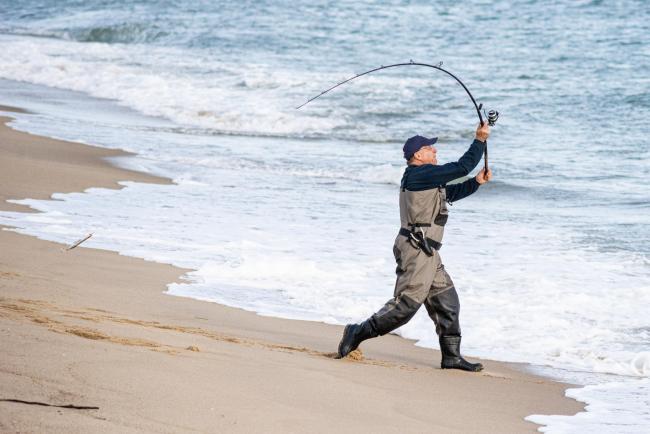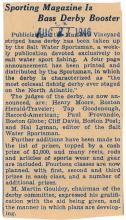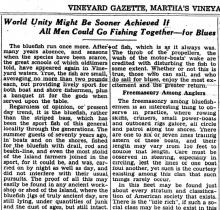The annual fall fishing derby offers the scientific community an ideal platform for monitoring the health of fish and for doing marine research. Gregory P. Skomal, a regional division of marine fisheries biologist, is involved in several key studies with the help of derby organizers.
Derby fishermen provide the perfect mechanism for monitoring fish. Four species of fish are weighed in almost daily, and all a researcher has to do is take his pick. And since the fish are all brought to the same spot for weighing in, it is easy to standardize.
Early in the month-long contest, Mr. Skomal, a sport fisheries specialist, concentrated on inspecting fish weighed in at the headquarters for signs of tiny parasites. Mr. Skomal collected these microscopic creatures on behalf of a biologist with the Tennessee Aquarium in Chattanooga.
A number of varieties of parasites may live on a fish. Most are smaller than a shirt button and they reside on a fish’s body, in its gills, mouth and even inside its nose. They are copepods, a kind of crustacean, and are as small as one centimeter in size.
“Almost every fish has a parasite on it,” Mr. Skomal said. The scientist directing the key research, Dr. George Benz, is looking at a number of factors that contribute to fish mortality. Factors include disease, predation and, in this case, parasitic infestation.
Using a bright light and a pair of tweezers, Mr. Skomal picked up the tiny creatures and put them in a small vial of alcohol. His search for parasites at the derby weigh-in site in Oak Bluffs was quick and not entirely complete, because each fish’s owner was patiently standing by, waiting. But there was an abundance of fish to choose from. Whenever an interesting specimen came to derby headquarters on Circuit avenue extension, Mr. Skomal asked if he could give it an examination.
Another research project involved age and growth rates. The study involved gathering bones and ears of false albacore and bonito. The research was being done in conjunction with Heather Haas, a student at the University of Massachusetts-Dartmouth. These two fish are among the fastest fish in the sea. Mr. Skomal said that the fish samples being gathered are part of a pilot study that could lead to a full academic research program.
Mr. Skomal also is assisting a New Jersey scientist who is researching the feeding habits of false albacore. In this study, Mr. Skomal is collecting false albacore stomachs. The stomachs are being collected and frozen for future shipment to a professor with the New Jersey Sea Grant Program, Eleanor Bochenek. “She is interested in regional feeding differences between false albacore,” he said.
Scientists want to know what is it that brings these fish northward. Are they in pursuit of a specific bait or are they following an instinct? By examining the content of the stomachs of fish in the waters of Martha’s Vineyard and comparing them to the stomachs of fish that are feeding in New Jersey waters, the scientists can perhaps determine why these fish move from one area to another.
“She wants to know whether these fish are feeding on the same bait in both regions,” he said. “Are they pursuing a specific bait?”
Then there is an easier ongoing study of fish and fishermen that is concurrent with the derby. Every year the contest keeps track of the numbers of fish weighed in at derby headquarters. At this fall’s derby, the contestants weighed in 374 striped bass, 622 bluefish, 263 bonito and 270 false albacore.
While there are many variables that contribute to those figures - the number of fishermen, the impact of weather Ñ the tallies are a useful snapshot of how fish stocks fare from year to year.
“There are very few month-long fishing contests in this country,” Mr. Skomal said. From this comes an impressive database. The data is useful because every fish is weighed in. For purposes of comparison, the state division of marine fisheries’ own annual saltwater fishing contest offers very little analytical help in evaluating fish stocks because no one knows about the fish caught that are not being weighed in.
Every seasoned recreational fisherman on the Vineyard has his own theories about the rise and fall of some stocks of fish. But this anecdotal information isn’t enough to be useful to the scientists in evaluating the health of various species of fish. There was a time, for instance, when fishermen thought that the bluefish did well when the striped bass cycle was at a low. And when the striped bass were doing well, the bluefish were in trouble. It was science that proved that there is no correlation.
Striped bass are coastal fish. They very rarely go out into deeper water. Very few striped bass are caught at Nantucket. Bluefish, on the other hand, are a hearty ocean-going fish and can be caught as easily on Georges Bank as Wasque. They spawn in the ocean and spend all of their time in pursuit of small fish and being pursued by sharks. Fishermen used to think that these two species competed for the same bait. Mr. Skomal said that this is not at all true.
But it may be true when comparing false albacore to bonito. These two species of fish appear to have a seesaw relationship. “There does appear to be an inverse relationship between bonito and false albacore,” Mr. Skomal said. The evidence appears in derby landing results from year to year. Last year the false albacore were up and the bonito were down. This year, the bonito and false albacore were evenly split. They were also evenly split in higher numbers.
Marine science serves not only those who are trying to understand these fish but also those who are trying to manage it. For decades, fishermen have tagged fish. At different coastal spots, fishermen have attached small plastic threads to the body of the fish. Months and years later the same fish may be caught by an angler. The tag is removed, data about the size of the fish is recorded, and both are sent to a clearing house for evaluation. From this data, fisheries scientists have been able to learn how long it takes a fish to grow, as well as where it was before it was caught.
Mr. Skomal said scientists still are far from understanding the creatures of the sea. What better place to do it than where every day hundreds of pounds of fish are measured, weighed and filleted?
“There are unique opportunities for marine science here on Martha’s Vineyard,” Mr. Skomal said.











Comments